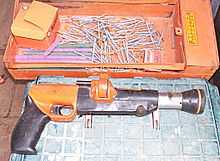Powder-actuated tool

A powder-actuated tool (often called a "Hilti gun" or a "Ramset gun" after their manufacturing companies) is a nail gun used in construction and manufacturing to join materials to hard substrates such as steel and concrete. Known as "direct fastening", this technology relies on a controlled explosion created by small chemical propellant charge, similar to the process that discharges a firearm.
Powder-actuated tools come in either high velocity or low velocity types. In high velocity tools the propellant acts directly on the fastener. This process is similar to a firearm. Low velocity tools introduce a piston into the chamber. The propellant acts on the piston, which then drives the fastener into the substrate. (The piston is analogous to the bolt of a captive bolt pistol.) A powder-actuated tool is considered to be low velocity if the average test velocity of the fastener does not exceed 492 feet per second (150 m/s). High velocity tools may not be made or sold in the United States, however some made decades ago are still in use in shipbuilding and steel industries.
Powder-actuated fasteners are usually nails made of high quality, hardened steel, although there are many specialized fasteners designed for specific applications in the construction and manufacturing industries.
Powder-actuated technology was developed for commercial use during the Second World War, when high velocity fastening systems were used to temporarily repair damage to ships. In the case of hull breach, these tools fastened steel plates over damaged areas.[1] These tools were developed by Mine Safety Appliances, for the United States Navy.[2] Powder-actuated tools were investigated and used prior to this development; they were used as part of submarine hunting during the First World War and were the subject of a 1921 United States patent (US Patent No. 1365869).[3]
Usage

Fasteners take various forms, for example with threaded ends to use as an embedded bolt, with washers at the tips that grip softer material etc.
Operation

Powder-actuated tool cartridges work similarly to blank firearm cartridges. In many cases, the charges are firearm cartridges with modified casings. The .22 Short, developed by Smith & Wesson is common. The powder is cordite. These charges may be hand-fed, or manufactured and distributed on a plastic strip. The charges are activated when a firing pin strikes the primer, which is an explosive charge in the base of cartridge. The primer ignites the cordite, which burns rapidly. The gases released by the burning of the propellant build pressure within the cartridge, which acts either on the head of the nail, or on the piston, accelerating the nail towards the muzzle.
Powder actuated tools can be variously classified:
- Direct acting (the charge acts directly on the head of the nail or high velocity), or indirect (using an intermediate piston or low velocity)
- Single-shot, or magazine-fed
- Automatic or manual piston cycling
- Automatic or manual feed of the charges
Color-coding:
Color-coding for the "rounds" or "single shots" (the three shot strengths or colors typically sold to the general public are brown, green and yellow in brass):
In brass casing:
Color-coding Velocity
- Grey 315 ft/s (96 m/s) - Brown 385 ft/s (117 m/s) - Green 490 ft/s (150 m/s) - Yellow 575 ft/s (175 m/s) - Red 675 ft/s (206 m/s) - Purple 755 ft/s (230 m/s)
In nickel (silver) casings:
- Grey 845 ft/s (258 m/s) - Brown 935 ft/s (285 m/s) - Green 1,025 ft/s (312 m/s) - Yellow 1,115 ft/s (340 m/s) - Red 1,205 ft/s (367 m/s) - Purple 1,295 ft/s (395 m/s)
Not all powder-actuated tools are rated for high capacity charges — the strongest charge (nickel - purple @ 1,295 ft/s (395 m/s)), for example, is dangerous in a tool not rated for its use.
Safety
As with their air-actuated cousins, powder-actuated guns have a muzzle safety interlock. If the muzzle is not pressed against a surface with sufficient force, the firing pin is blocked and cannot reach the load to fire it. This ensures that the gun does not discharge in an unsafe manner, causing the nail to become a projectile. Nonetheless, good judgment should always be used when using a powder-actuated nail gun, since the nail is driven with far more force than an air-actuated gun. The surface being nailed should, therefore, certainly be capable of stopping and holding the nail.
Most manufacturers of powder-actuated nail guns offer training and certification. Many projects and employers require this before an employee is permitted to use the tool.
The ownership and use of these tools is regulated in Australia. The owner has to register the tool, and an operator of one of these tools is required to have a license and to have undergone training in their use. These laws are in keeping with Australia's extremely strict firearm laws.
In the US, failure to properly dispose of charges is a common OSHA safety violation. Training is required before someone can use the tool on a jobsite.
In popular culture
In the TV series The Wire, a real Hilti brand powder-actuated tool is pitched to the character Snoop in episode 1, season 4. The tool also features in subsequent episodes.
External links
See also
References
- ↑ "Engineering maintenance". Hospital Management (Clissold Publishing Co) 90: 52. 1960.
- ↑ "Powder-actuated driver". The Signalman's journal (Brotherhood of railroad signalmen of America). 29–30. 1948.
- ↑ "Powder-actuated fasteners". Engineering journal (American Institute of Steel Construction). 40–41: 99. 2003.